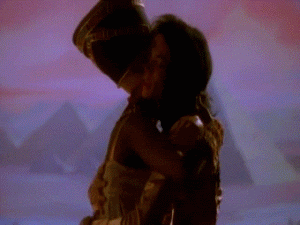What does Black love feel like?
Many of us have grown up listening to sultry sexy artist like D’Angelo, Jodeci, Janet Jackson, Sade, Ginuwine and SWV. These are just a few of many R&B artists that have provided the perfect soundtrack to serenade your lover. If you had the perfect night in with your lover, D’Angelo’s “Brown Sugar” or Monica’s “Angel of Mine” probably set the mood and help the one you loved most understand and sense what you were feeling. However, one important aspect of these artists and their passionate love songs is how the artist and director were both able to create an intimate imagery of Black love and sexuality that was nostalgic and beautiful.
What does Black love look like?
 If I had to decide, to me it looks like Erykah Badu and Andre 3000 in her 1997 song “Otherside of the Game”. Erykah describes the commitment and love she has for her Black man and the things she goes through as the girlfriend of a drug dealer. In the video, you see a pregnant Erykah and a busy Andre 3000 co-existing in their loft starting their day. Importantly, this song provides an iconic soundtrack to what they are experiencing that morning along with showcasing their love as she wakes Andre up, they play fight, he caresses her belly and holds her tight as they embrace. This video provides an everydayness of waking up together and loving each other where others who watch the video can resonate with.
If I had to decide, to me it looks like Erykah Badu and Andre 3000 in her 1997 song “Otherside of the Game”. Erykah describes the commitment and love she has for her Black man and the things she goes through as the girlfriend of a drug dealer. In the video, you see a pregnant Erykah and a busy Andre 3000 co-existing in their loft starting their day. Importantly, this song provides an iconic soundtrack to what they are experiencing that morning along with showcasing their love as she wakes Andre up, they play fight, he caresses her belly and holds her tight as they embrace. This video provides an everydayness of waking up together and loving each other where others who watch the video can resonate with.
I also think in Joe’s video, “All The Things Your Man Wont Do”, there is sex appeal and curiosity between him and his lover. In the beginning, you see Joe confessing his love to a woman on a pay phone and telling her that she deserves better. 
This inevitably leads him to make an appearance at her job where he continues to serenade her and convince this Black woman that he possesses qualities that her current boyfriend does not. Throughout the video, the director creates a late-night mood and intimacy that is shared between the two. This is seen in the way the young woman flirts with Joe in the restaurant and making the ultimate sacrifice to take a chance with a better man
How far will Black love go?
 A classic R&B music video that had a more scandalous storyline, but still had meaningful lyrics was Michael Jackson’s “Remember the Time”. Boyz n the Hood director John Singleton, directed his first music video which was set in ancient Egypt and starred Eddie Murphy and supermodel Iman. Although Michael Jackson also serenaded someone else’s wife in the video, this video honored Black people as rulers of ancient Egypt, the fight for love and an amazing dance sequence with both Black men and women of all shades. This video, in particular, reflects on the past of two lovers while still honoring the beauty of Black love and Blackness through the wardrobe selection and various skin tones of Black characters and dancers.
A classic R&B music video that had a more scandalous storyline, but still had meaningful lyrics was Michael Jackson’s “Remember the Time”. Boyz n the Hood director John Singleton, directed his first music video which was set in ancient Egypt and starred Eddie Murphy and supermodel Iman. Although Michael Jackson also serenaded someone else’s wife in the video, this video honored Black people as rulers of ancient Egypt, the fight for love and an amazing dance sequence with both Black men and women of all shades. This video, in particular, reflects on the past of two lovers while still honoring the beauty of Black love and Blackness through the wardrobe selection and various skin tones of Black characters and dancers.
While many 90s artists brought us sexy and intimate love ballads, their music videos accompanied imagery that made you believe in Black love that was complicated, honest and sincere. While the videos discussed aren’t true to every relationship, these videos did portray a side of Black love and intimacy that wasn’t easily found in the typical raunchy Hip-Hop videos. R&B music videos were able to tastefully showcase all shades of Blackness that wasn’t necessarily misogynistic or overly provocative. However, it did showcase a variation of Black love and intimacy that took place in ordinary locations such as the subway, club or local coffee shop. A brotha would proclaim his love in the rain, or on the phone. A sistah would make a late night trip to her man’s crib or wake him up and sing to him in the early morning. Either way, watching and reminiscing on 90s R&B I’m sure one could find the perfect video that embodies and reflects how they feel about their Black love. — Adeerya J.


